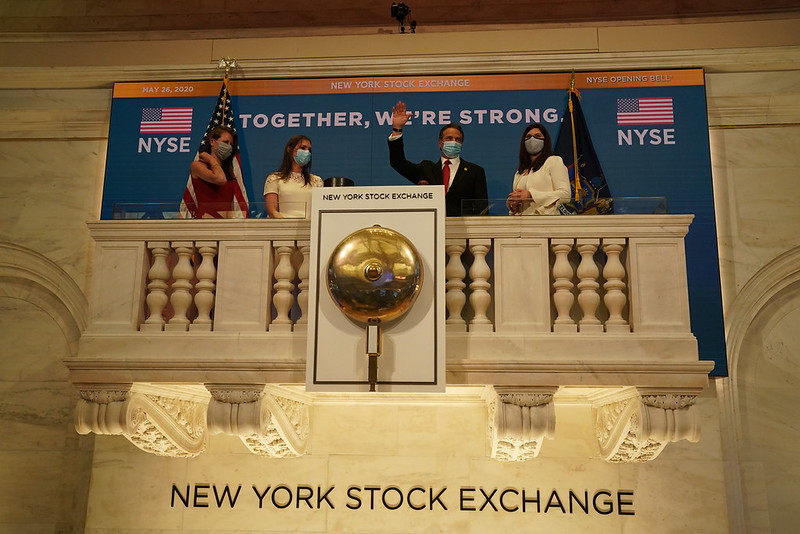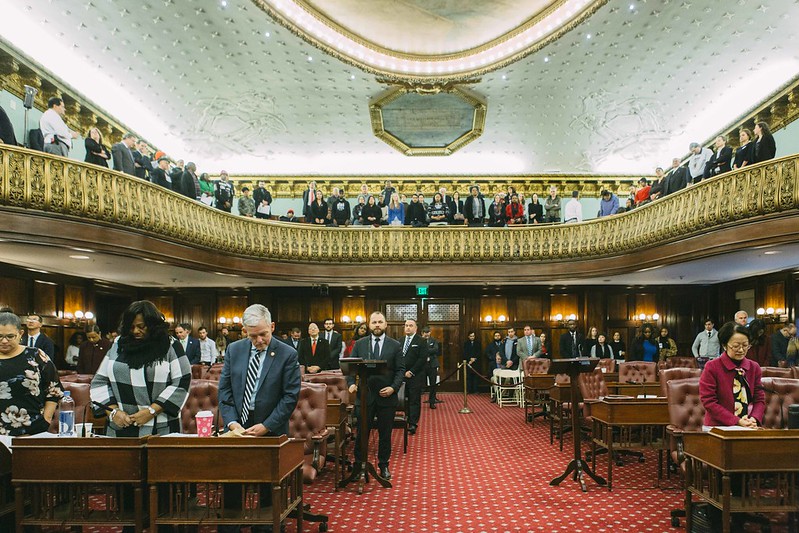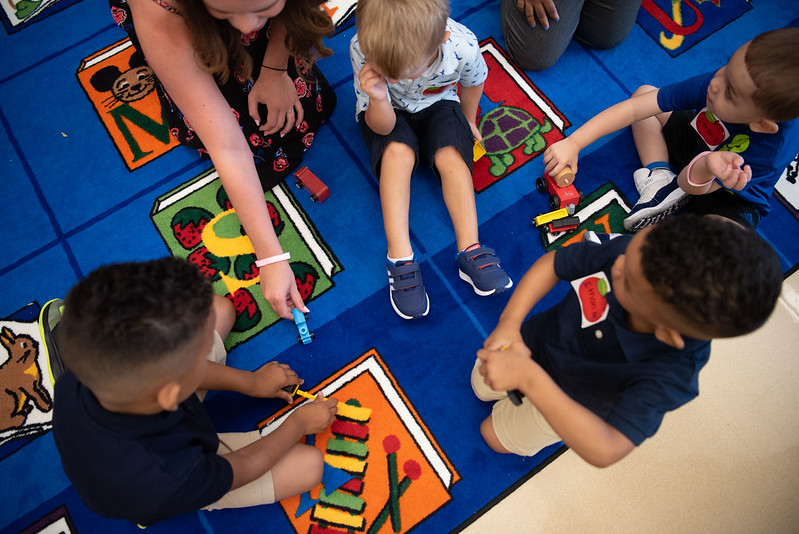A Wall Street Investor and an Unemployed Immigrant Cook Agree: Tax Billionaires, Support Excluded Workers

Gov. Cuomo at the New York Stock Exchange (photo: Don Pollard/governor's office)
Income inequality in our state was a crisis before anyone had even heard of COVID-19, but five months into the pandemic, it is now a question of life or death for millions of New Yorkers.
As two individuals sitting on opposite sides of that inequality divide, we are united in our demand to the State of New York: we must tax the rich, and we must do it right now.
One of us, Morris Pearl, is a millionaire. I built my fortune on Wall Street, but I retired from that job after deciding that I wanted to concentrate on making the world a better place.
Now, I make most of my money off passive investments. In the middle of an unprecedented economic crisis those investments are doing better than ever. Investing doesn’t use much of my labor and it barely takes up my time, and yet it’s made me wealthier than millions of other New Yorkers who actually need to work for a living. And thanks to our state lawmakers’ unwillingness to tax folks like me fairly, I pay significantly lower tax rates on what I earn from my investments than most New Yorkers do for what they earn from their hard work.
On the other side of things I, Ajay Puran, lost my job at a roti shop in Richmond Hill back in March as the economy shut down. I’m 16 years old and go to high school. But I’m also the oldest child in a family of six, so I used to work 8-10 hour shifts on weekends to help pay the rent and support my younger brothers and sister. Because of the pandemic, my mom and I both lost our jobs. We became dependent on my dad’s income alone - even though his work wasn’t regular and his job didn’t bring in anywhere near what we need to survive. I recently found another job occasionally cleaning and sanitizing the apartments of rich people in Manhattan who left the city. But our income is still a tiny fraction of what we used to live on.
My family and I are undocumented. No one in my family is eligible for a single dollar in unemployment or any emergency income. When we can find work, my dad and I are working what everyone calls “essential” jobs and we’re getting a lot of thank yous. But no amount of thank yous will put food on our table or help us to pay the rent. As undocumented people we are somehow keeping this country running through our essential work, but then when there is no paid work available, we are excluded from all unemployment assistance and other income to help us survive.
Many families like us have to make a choice between working while sick or becoming homeless. And in a pandemic, everyone else in New York is only as safe and healthy as my family, and all the other undocumented people who live here.
We both agree that this sorry state of affairs is not inevitable.
Millions of New Yorkers are suffering, and the state government can offer more assistance to the people who need it most, including undocumented immigrants. There’s plenty of money available to spend, it’s just in the bank accounts of New York’s wealthy. All we need is for the state Legislature and Governor Cuomo to step up and understand that protecting the lifestyles of the rich in the long-term means to protect the most vulnerable New Yorkers now, not keeping the wealthy’s taxes low in the short-term.
A bill introduced in the New York Legislature would address this problem by changing the way our state’s billionaires are taxed to provide direct relief to families excluded from unemployment benefits. The proposed billionaires tax would raise an estimated $5.5 billion per year and could provide direct aid to the most vulnerable New Yorkers in a flat amount that matches what other low wage workers receive in unemployment insurance.
While the rest of the state struggles to stay afloat in this crisis, New York’s 119 billionaires have increased their net worth by leaps and bounds since the start of the pandemic, with some estimates reaching $600 billion.
We have more billionaires than anywhere else in the world, and yet they pay lower state and local tax rates than New York’s teachers and truck drivers. This should be an easy call. Our state could finally, after all these years of ignoring the growing problem, start to bridge the gap between the two of us if we just tax those billionaires to fund excluded workers.
***
Morris Pearl is the Chair of the Patriotic Millionaires. Ajay Puranis a member of Desis Rising Up and Moving (DRUM). On Twitter: @Morris_Pearl & @DesisRisingUp.
***
Have an op-ed idea or submission for Gotham Gazette? Email This email address is being protected from spambots. You need JavaScript enabled to view it.
How Development Should Be Decided in New York City

City Council (photo: Emil Cohen/City Council)
We are at a critical turning point in New York City’s history. Large-scale development projects, pushed by big real estate interests and the business class after September 11, 2001, did not give New Yorkers the promised security to avoid the Great Recession, or the next crisis, COVID-19. Meanwhile, a lack of investments in social programs shredded the social safety net New Yorkers were told would save them if they lost their jobs or homes.
If there is any time to insist on accountability before approving massive developments, it is now. That is why we oppose Industry City and YourLIC in our respective City Council districts.
We cannot allow for more displacement and suffering to befall our most vulnerable constituents based on empty promises alone. Yet the real estate lobby (REBNY) and the business class are trotting out the same failed talking points and pushing our City Council colleagues to overrule us.
This is unsurprising. The business class loves “member deference” when it aligns with their interests, and rail against it when it does not. But what is remarkable is how some of our colleagues who should know better agree with them. They say the stakes are too high for us to decide alone, despite us having won the confidence of our constituents at the ballot box and knowing our communities intimately.
Our colleagues are right about one thing – the stakes are too high. According to some estimates, 1.4 million New Yorkers are at risk of eviction because of COVID-19. Around 100,000 are already homeless. Half of all immigrant New Yorkers are unemployed, even though they represent half of all essential workers. And while our most vulnerable neighbors lost their lives and livelihoods, billionaires profited off their misery and are doing better than ever.
The dangerous precedent we must undo is not the Council’s tradition of member deference but our deference to developers. Insanity is doing the same thing repeatedly while expecting different results. If we give developers a blank check in Brooklyn and Queens, despite lacking any accountability to their neighbors to deliver on their promises, we will re-create the very conditions that put New Yorkers in harm’s way to begin with.
Many things must change about how we make land use decisions. The city’s process - ULURP - is flawed and Council members are not always right. But member deference creates accountability at the ballot box, where it belongs. Eliminating member deference would disconnect the votes of our constituents from the decision-making process and give power to whoever can lobby and organize the Council best, regardless of the merits of any proposal.
In other words, member deference prevents the rich and powerful from pushing through projects over the objections of local communities. Ending member deference, during the worst economic crisis in a century when New Yorkers are calling for change, would make our city into a playground for the wealthy again and further displace working class New Yorkers, especially our Black, Latino, and immigrant neighbors.
Every year, developers promise New Yorkers jobs in exchange for our support. But proof matters more than promises, especially now. If we are to prevent the next economic crisis, we must insist on accountability, and resist the siren calls of economic collapse from the ones most responsible for it.
***
City Council Members Carlos Menchaca and Jimmy Van Bramer represent parts of Brooklyn and Queens, respectively. On Twitter @CMenchaca & @JimmyVanBramer.
***
Have an op-ed idea or submission for Gotham Gazette? Email This email address is being protected from spambots. You need JavaScript enabled to view it.
When the School Segregationist Dog Whistle Becomes a Bullhorn

Students at school (photo: Michael Appleton/Mayor's Office)
Dog-whistle politics refers to the use of racially-coded language as a strategy to rally perceived allies while providing plausible deniability against charges of racism. Donald Trump and the Republican Party regularly use racist dog whistles in the context of immigration, policing, public benefits, and school integration by rallying around the idea of an external racial threat of people of color to ‘white America.’ However, there is no one political party or region of the United States with a monopoly on dog-whistle politics. Even in “liberal” New York City, the debate around school integration continues to escalate and bubble over as the racist dog whistle becomes a booming bullhorn.
New York City remains one of the most segregated school districts in the country. For the past few years, educational equity advocates have proposed a number of educational reforms to address this problem. The most controversial reforms involve school integration, which have engendered controversy and backlash from conservatives and self-described liberals alike.
In 2018, Upper West Side parents vehemently opposed integration plans that would set aside a percentage of middle-school seats in their district for students with lower exam scores. As one white parent said at a meeting: “You’re telling them that 'You’re not going to go to a school that’s going to educate them the same way you’ve been educated.' Life sucks! Is that what the DOE [Department of Education] wants to say?” Many white liberals and moderates deploy dog whistles to defend their position that racial integration will destroy the “good” schools, or take opportunities away from allegedly more deserving, gifted, and hardworking white and Asian-American students.
These school integration debates have raged on, perhaps most fervently, concerning efforts to reform admissions standards at New York City’s specialized high schools. Currently, admissions to these elite schools is based on a single, high-stakes, standardized test called the SHSAT. Black and Latino students in New York’s eight so-called specialized high schools stand at an abysmal rate of around 11 percent, despite constituting 70 percent of New York City’s public school system.
Reporting by Nikole Hannah-Jones, Pulitzer Prize winning New York Times journalist and director of the 1619 Project, brought national attention to the school integration debate in New York City. Her interview with Maud Maron, who currently serves as president of the Community Education Council for District 2 in Manhattan, drew outrage precisely for Maron’s use of dog whistles to oppose school integration.
As a follow-up to Maron’s remarks opposing the Department of Education’s school integration proposals, Hannah-Jones asked: “What desegregation efforts then would you support?” Maron replied that it depends: “you have to have community buy-in,” and continued, "when people say I'm nervous that this is going to result in my kid getting a less good education, you have to take that concern as a valid concern—even if you think it's racist, and it may be."
We must heed Martin Luther King Jr.’s criticism of the white moderate, "who constantly says: 'I agree with you in the goal you seek, but I cannot agree with your methods of direct action'; who paternalistically believes he can set the timetable for another man's freedom." Maron is a textbook example of the white moderate of whom King warned, telling Hannah-Jones that Black people must wait for a more convenient time for people like her and the many privileged parent leaders to become comfortable with integration.
Like many opponents to school integration, Maron’s comments trivialize and dismiss the benefits of school integration when rivaled with her concern that white children would have to share the same educational space and opportunities with Black and Latino children. In addition to opposing school integration, Maron and her ilk unsurprisingly oppose culturally responsive education and implicit bias training for educators.
These anti-integration advocates hold an outsized influence over education policy, occupying critical seats on their local community education councils. And they seek to grow their influence and power, including through upcoming city elections. Maron is now taking her education platform and running on it, as a Democrat, for New York City Council in the 2021 election.
Despite Maron’s attempts to portray herself as a “liberal,” time and again she has fought against organizations like Teens Take Charge, a youth-led group that fights for educational equity, and more recently targeted a youth activist of color for raising allegations of racism with her political campaign. In response to her critics, Maron published an op-ed identifying herself as a public defender as a liberal bona fide. She goes on to say that anti-racism is what invites discrimination, and then characterizes education equity advocates as race-obsessed. In response, the Black Attorneys of Legal Aid and The Legal Aid Society, Maron’s employer, both issued statements condemning Maron’s brand of liberal racism.
Maron is no longer only speaking to Tribeca moms who secretly oppose integration in hushed voices. She is publicly dabbling in the rhetoric popularized by Donald Trump and his right wing supporters who attack and deride antiracism as political correctness and cancel culture. She has even galvanized an online army of vile racism denialists who harass and dox anyone who criticizes Maron or her segregation activism.
One of Maron’s most ardent supporters include Thomas Wrocklage, a fellow CEC member, lawyer, and co-founder of the anti-integration nonprofit called PLACE NYC. Wrocklage comfortably engages in a range of aggressive antics to harass Maron’s critics, going as far as to dox multiple of Maron’s Black and women colleagues and fellow CEC members, and indefensibly harassing teenagers from Teens Take Charge. Maron has not denounced the offensive tactics or racist views espoused by her supporters on her behalf.
Ultimately, the segregationist views of Maud Maron and Thomas Wrocklage are not new or unique. Attacking school integration is as American as apple pie. It is the story of the Little Rock Nine, a group of nine Black students who integrated Little Rock High School in Arkansas in 1957—only two years after Brown v Board of Education held that segregation of public schools was unconstitutional. The Little Rock Nine faced white mobs and riots, and the Arkansas National Guard was sent in to stop these nine Black children from entering their school.
This legacy of anti-Black racism and logic lives on. White mothers fought to uphold Jim Crow—they saw their moral authority derive from protecting their white children from the racial threat of integration. While people like Maud Maron seemingly couch their arguments against school integration in a thin veil of parental concern, they remain on the wrong side of history.
It is our duty to go beyond denouncing brazen, bullhorn racism. For far too long and often, more subtle, covert forms of racism go unchecked. To be clear, this is not simply a matter of political correctness or word choices. The issue before us is that the promise of Brown, 66 years later, has not been realized. We must expose and challenge the systemic racism that underpins dog whistles, and bullhorns alike, if we are to have a chance at real integration.
***
Rigodis Appling, Diana Nevins, Olayemi Olurin, and Jason Wu are public defenders in New York City. On Twitter @rigodis, @artemis_nieves, @msolurin, @criticalrace.
***
Have an op-ed idea or submission for Gotham Gazette? Email This email address is being protected from spambots. You need JavaScript enabled to view it.




